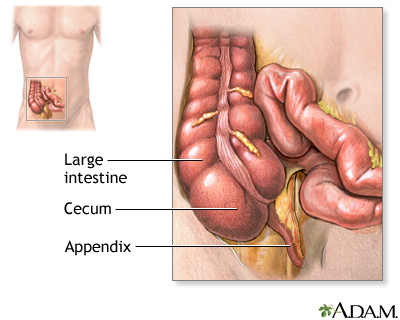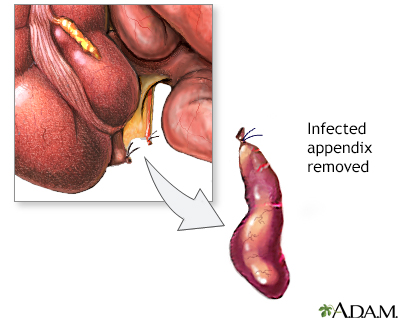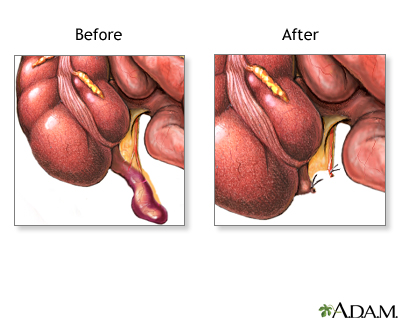Appendectomy
Normal anatomy
|
|
The appendix is a small, finger-shaped pouch of intestinal tissue located between the small intestine (cecum) and large intestine (colon).
|
Indications
|
|
If the appendix becomes infected it must be surgically removed before it ruptures and spreads infection to the entire abdominal space. Symptoms of acute appendicitis include pain in the lower right side of the abdomen, fever, reduced appetite, nausea or vomiting.
Before surgery, the doctor will perform a physical exam. The physician will check the abdomen for tenderness and tightness and check the rectum for tenderness and an enlarged appendix. In women, a pelvic exam is also performed to exclude pain caused by the ovaries or uterus. Additionally, blood tests and x-rays may also be performed.
There is no test to confirm appendicitis and the symptoms may be caused by other illnesses. The doctor must diagnose from the information you report and what he sees. During appendectomy surgery, even if the surgeon finds that the appendix is not infected (which can happen up to 25% of the time), he will thoroughly check the other abdominal organs and remove the appendix anyway.
|
Incision
|
|
Depending upon the circumstances of the individual patient, an appendectomy can be performed in one of two ways, through an open incision or with a laparoscope.
In the open technique, an incision is made in the lower right side of the abdomen, through the skin, muscle wall, and peritoneum. The appendix is located and then carefully freed from the surrounding structures and removed.
In the laparoscopic technique, several small incisions are made in the abdomen. In one incision a laparoscope is inserted. The laparoscope has a tiny lens to which a TV camera is attached. The appendectomy is performed by the surgeon while looking at the TV monitor. Small instruments are inserted in the other incisions and used to remove the appendix.
|
Procedure
|
|
If a pocket of infection has formed, or the appendix has ruptured, the abdomen will be thoroughly washed out during surgery. The surgeon may then leave the skin open and allow it to heal together on its own, to allow the infection to drain, or less frequently, put in a small drainage tube.
|
Aftercare
|
|
Recovery from a simple appendectomy is usually complete and rapid. Most patients can go home the day after the operation, and resume normal diet and activities within one to two weeks. If the appendix has developed an abscess or has ruptured, the recovery may be slower and more complicated, requiring use of medications to treat the infection (antibiotics).
Living without an appendix causes no known health problems.
|

Review Date:5/2/2023
Reviewed By:Michael M. Phillips, MD, Emeritus Professor of Medicine, The George Washington University School of Medicine, Washington, DC. Also reviewed by David C. Dugdale, MD, Medical Director, Brenda Conaway, Editorial Director, and the A.D.A.M. Editorial team.
The information provided herein should not be used during any medical emergency
or for the diagnosis or treatment of any medical condition. A licensed medical professional
should be consulted for diagnosis and treatment of any and all medical conditions. Call 911
for all medical emergencies. Links to other sites are provided for information only -- they
do not constitute endorsements of those other sites. © 1997-A.D.A.M., Inc. Any duplication or distribution of the information contained herein is strictly prohibited.
The Agency for Health Care Administration (Agency) and this website do not claim the information on, or referred to by, this site is error free. This site may include links to websites of other government agencies or private groups. Our Agency and this website do not control such sites and are not responsible for their content. Reference to or links to any other group, product, service, or information does not mean our Agency or this website approves of that group, product, service, or information.
Additionally, while health information provided through this website may be a valuable resource for the public, it is not designed to offer medical advice. Talk with your doctor about medical care questions you may have.





